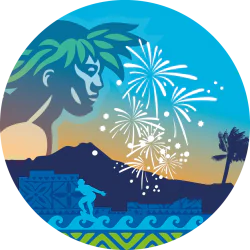Honolulu Marathon is a go, with planning already underway
Honolulu Marathon is a go, with planning already underway
This year’s Honolulu Marathon is officially on, with capacity limits now imposed on road races slated to be lifted next week.
Honolulu Mayor Rick Blangiardi on Wednesday announced that effective Wednesday, road races — currently limited to 500 participants — may be staged with an unlimited count of vaccinated participants.
In response, Dr. Jim Barahal, chief executive officer of the Honolulu Marathon Association, said: “We’re grateful, thankful, excited for the community, and for the participants.” He added “We’re excited to begin the countdown to the marathon.”
Earlier this week, the event’s fate seemed to be still up in the air because current city COVID-19 rules limiting participation appeared to have derailed feasibility of covering fixed costs. Even so, Barahal continued to forge ahead with planning, taking a leap of faith that vaccination rates would continue to rise, coronavirus case counts would continue to decline, and restrictions would be eased.
“We actually made a decision about a month ago that we had to move forward as if it was going to happen or else we would create a self-fulfilling prophecy it wouldn’t happen,” he said. “We had no option, we felt, other than to move forward as if it’s going to happen.”
While some details still have to be ironed out, Barahal said, but he feels validated, and is excited about moving forward with certainty. It would, he said, be the largest event held in Hawaii since the onset of the pandemic in March 2020.
To date, a total of some 14,000 participants are signed up for the Dec. 12 Honolulu Marathon and related runs. The Kalakaua Merrie Mile is set for Dec. 11, and the Start to Park 10K, Dec. 12. About 10,000 participants are signed up for the 26.2-mile marathon, which starts on Ala Moana Boulevard and ends at Kapiolani Park.
The majority of participants are kamaaina who took advantage of early registration fees of $68 (now $185), which opened up in June. The number of Japan visitors has dropped dramatically. This year, there are only 239 entries from Japan, so far — down from about 17,000 in previous years.
Japan entries make up about 40% to 50% of revenues, said Barahal, so the marathon expects to take a big hit this year. But he’s hopeful that registration will rise with further announcements on international travel opening up next month.
In 2019 Honolulu Marathon events attracted about 34,000 participants. Despite the expectation for heavily scaled-down participation, Barahal said it’s important to make Honolulu Marathon happen this year as a sign that the community is ready to move forward.
“The symbolic importance of the marathon, I think, to the community is paramount this year,” said Barahal. “We think it would be detrimental not to do it two years in a row. We think it’s important symbolically to keep the Honolulu Marathon out there in the marathon world.”
Additionally, holding the event sends a message that life is returning to some semblance of normal — and a signal to Japan travelers that Hawaii is open and welcomes them back, he said.
As a physician, Barahal has been paying attention to how other cities are handling road races. The Chicago, Boston, and London marathons were staged earlier this month, and the New York Marathon is scheduled in early November. To underscore safety, some events have required proof of vaccinations when picking up race bibs and timing chips.
Putting on the event will still be at an enormous cost, requiring some 400 special-duty officers to keep the event safe, patrol closed intersections, and provide road security. “We have to secure 26.2 miles of roadway,” he said. “Whether we have 100 people out there or 30,000, the cost is roughly the same.”
The event is expected to include staggered start times — up to 200 participants allowed at a time — so there will not be the shoulder-to-shoulder crowding at the Ala Moana start line. Organizers still plan to continue to tradition of starting the marathon with an early-morning fireworks display. Masks will not be required while running the marathon.
Also, Barahal said each runner will be issued an 8-ounce, reusable water bottle — 18,000 have been purchased — along with the T-shirts and finisher medals.
The association has devised automated water stations, where runners will be able to fill their own water bottles. There will be manned stations, as well, and medical aid will be available.
The tradition of handing out free malasadas to finishers after the marathon is also here to stay. After losing their regular caterer during the pandemic, the association invested $40,000 in kitchen equipment, which will be used for making malasadas.
The Running Room Val Nolasco half-marathon in November is also going forward in person, and had initially opened it up to 500 runners with proof of vaccination, according to current guidelines.
If the marathon — for some unforeseen reason — does not happen, registrants can transfer their entry fees to the Virtual Beachfest, a virtual race and event, which is happening concurrently and has about 2,400 entries, or defer the credit for the Honolulu Marathon next year.
Barahal expects the marathon to happen as planned, though. “It’s going to look real different, but we still think it’s going to be fun and joyous, and we are excited to take back the roads on Dec. 12,” he said.




